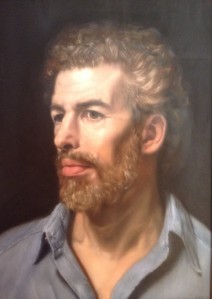In-Sight Publishing
Born to do Math 4 - 1,001 and the Box (Part 2)
Born to do Math 4 - 1,001 and the Box (Part 2)
Scott Douglas Jacobsen & Rick Rosner
March 11, 2017
[Beginning of recorded material]
Scott Douglas Jacobsen: So they 3-dimensionally or 4-dimensionally ooze
out, of a box, say? [Laughing] Where the box itself is oozing,
probabilistically as a cloud?
Rick Rosner: You need 4 dimensions because
that’s what the world is. If you detected the electron in the box at T=0, and
T=1, T=2, T=3. You’ve got a reasonable probability that the electron has been
trapped in the box. Though even that’s not 100%. It is based on the information
that you’ve gathered. But let’s say you’ve tested that electron 400 times, and
it has been in the box every time.
There’s still a non-zero chance that the
electron won’t be in the box, even though it is a closed box, the next time you
test it because electrons are incompletely, particles are incompletely, located
in space and that electron’s wave function may find itself mostly out of the
box to the point where if you tested, it wouldn’t be in the box. It would be
out of the box the next time you test it, or the 3,000th time, or
the 30 quadrillionth time you test it.
So numbers, we use them as if they are
infinitely precise, but in the real world there’s a certain probability that
what number you think applies to the number of things you’re looking at is
wrong. It is certainly wrong if you look at the number of pigeons. If there’s a
bunch of pigeons sitting on a light pole with 17 pigeons. You have, maybe, a 10
or 11% chance of being right. There’s a lot of uncertainty.
You haven’t counted them one-by-one. You’ve
taken at quick glance. Other things can affect your certainty when looking at a
group of things and then trying to characterize that with a number. There are
probably more metaphysical dimensions to whether something can be described or
how using integers to describe the numbers of things out in the world are
subject to other metaphysical uncertainties.
But small metaphysical uncertainties because
an apple is an apple. There’s a very small probability that it is somehow 2
apples because you don’t have perfect, precise information about everything out
in the world. There’s a small chance that what you saw as one apple is really a
different number of apples.
S: I should change the previous statement of mine from natural and whole
numbers to integers. [Laughing] Please continue.
R: Things tend towards whole numbers. Like
apples tend to come in units of one, it’s convenient for apples and for the
world for things to exist as discrete objects in the world. And that’s due to,
at the deepest level, the things that exist having to follow the rules of
self-consistency or non-contradiction.
S: Are math and logic identical in this way?
R: I don’t know. Math and logic both rest on
simple forms and manipulations of things that represent—numbers represent
themselves. They represent unitary objects out in the world. But it all comes
from the rules of non-contradiction. Something can’t both exist and not exist,
at least in a well-formed world, in a macro world.
S: If the physics of the universe rest on the Law of Contradiction
founded, and the Laws of Logic, by Aristotle, and various other things, and if
the physics of human computation and other conscious beings that have
information processing capacity rest on a similar physics because an
isomorphism exists between the universe and conscious beings’ information
processing capacity and computation, then the inability of the universe to have
infinite precise knowledge about itself implies that our conceptions of
infinity are themselves finite because we are small, finite systems in a bigger
finite system.
R: You can use logic to bootstrap. We use numbers
as you said, which are infinitely precise even though we don’t an infinite
amount of precision in anything, but the logic that is involved with numbers
allows us to pretend numbers are infinitely precise or do operations on numbers
as if they are infinitely precise, and numbers pop up in math and in the world
because they rest on simple, non-contradictory forms, and simple
non-contradictory forms arise all over the place.
Because they are simple, and because they are
non-contradictory, and being non-contradictory they are allowed to exist, which
is a little bit hand-wavey. But that’s enough for this thing.
[End of recorded material]
Authors[1]

Rick Rosner
American Television Writer
RickRosner@Hotmail.Com
Rick Rosner

Scott Douglas Jacobsen
Editor-in-Chief, In-Sight Publishing
Scott.D.Jacobsen@Gmail.Com
In-Sight Publishing
Endnotes
[1] Four format points for the session article:- Bold text following “Scott Douglas Jacobsen:” or “Jacobsen:” is Scott Douglas Jacobsen & non-bold text following “Rick Rosner:” or “Rosner:” is Rick Rosner.
- Session article conducted, transcribed, edited, formatted, and published by Scott.
- Footnotes & in-text citations in the interview & references after the interview.
- This session article has been edited for clarity and readability.
- American Psychological Association. (2010). Citation Guide: APA. Retrieved from http://www.lib.sfu.ca/system/files/28281/APA6CitationGuideSFUv3.pdf.
- Humble, A. (n.d.). Guide to Transcribing. Retrieved from http://www.msvu.ca/site/media/msvu/Transcription%20Guide.pdf.
License
In-Sight Publishing and In-Sight: Independent Interview-Based Journal by Scott Douglas Jacobsen is licensed under a Creative Commons Attribution-NonCommercial-NoDerivatives 4.0 International License.
Based on a work at www.in-sightjournal.com and www.rickrosner.org.
Copyright
© Scott Douglas Jacobsen, Rick Rosner, and In-Sight Publishing and In-Sight: Independent Interview-Based Journal 2012-2017. Unauthorized use and/or duplication of this material without express and written permission from this site’s author and/or owner is strictly prohibited. Excerpts and links may be used, provided that full and clear credit is given to Scott Douglas Jacobsen, Rick Rosner, and In-Sight Publishing and In-Sight: Independent Interview-Based Journal with appropriate and specific direction to the original content.
No comments:
Post a Comment